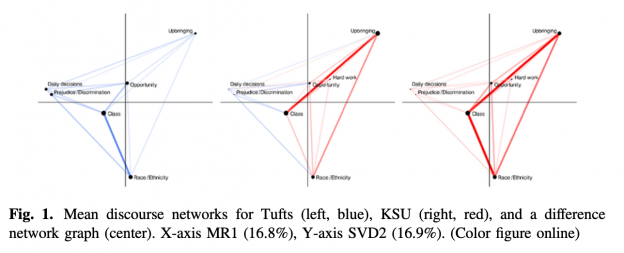- Facebook150
- Threads
- Bluesky
- Total 150
In 2015, students at my university, Tufts, and at Kansas State University discussed the same topic–the social determinants of health–in online forums. Colleagues and I analyzed the text in a novel way. The underlying theory is that conversations can be modeled as networks, where the nodes are specific ideas and the links are reasons and other connections that people assert. Specifically, we sought to use Epistemic Network Analysis (ENA) to model and compare the conversations. ENA is now very easy to use online and I have been playing with it for other purposes. One of its distinctive features is its ability to locate specific ideas at meaningful locations on a two-dimensional graph so that you can see dimensions of agreement and disagreement.
Our results are now published as Peter Levine, Brendan Eagan & David Williamson Shaffer, “Deliberation as an Epistemic Network: A Method for Analyzing Discussion,” in Barbara Wasson and Szilvia Zörgo (eds.), Advances in Quantitative Ethnography, proceedings of the Third International Conference, ICQE 2021 Virtual Event, November 6–11, 2021 (Springer Switzerland, 2022), pp. 17-33.
The image I reproduce with this post shows one particular ENA visualization of the discussions. The one at Tufts is in blue; the one at KSU is in red; and the one in the middle shows the difference between them (literally, the Tufts network subtracted from the KSU network).
You would have to read our paper to get a full explanation, but here is a glimpse. Basically, the Tufts students tended to connect inequities in health with race and class. Some of the KSU students also made those connections, but some of them drew connections between bad health outcomes and personal behavior, for which they blamed individuals’ upbringings. Thus the KSU discussion roughly looks like a triangle with three corners (race and class, personal choices, and health outcomes), while the Tufts discussion omits one of those corners.
The same result might have been clear enough from a conventional approach–reading, interpreting, and (possibly) coding the transcripts. However, we argue that the plausibility of the ENA findings validates the method, which can then be used to model other discussions.
